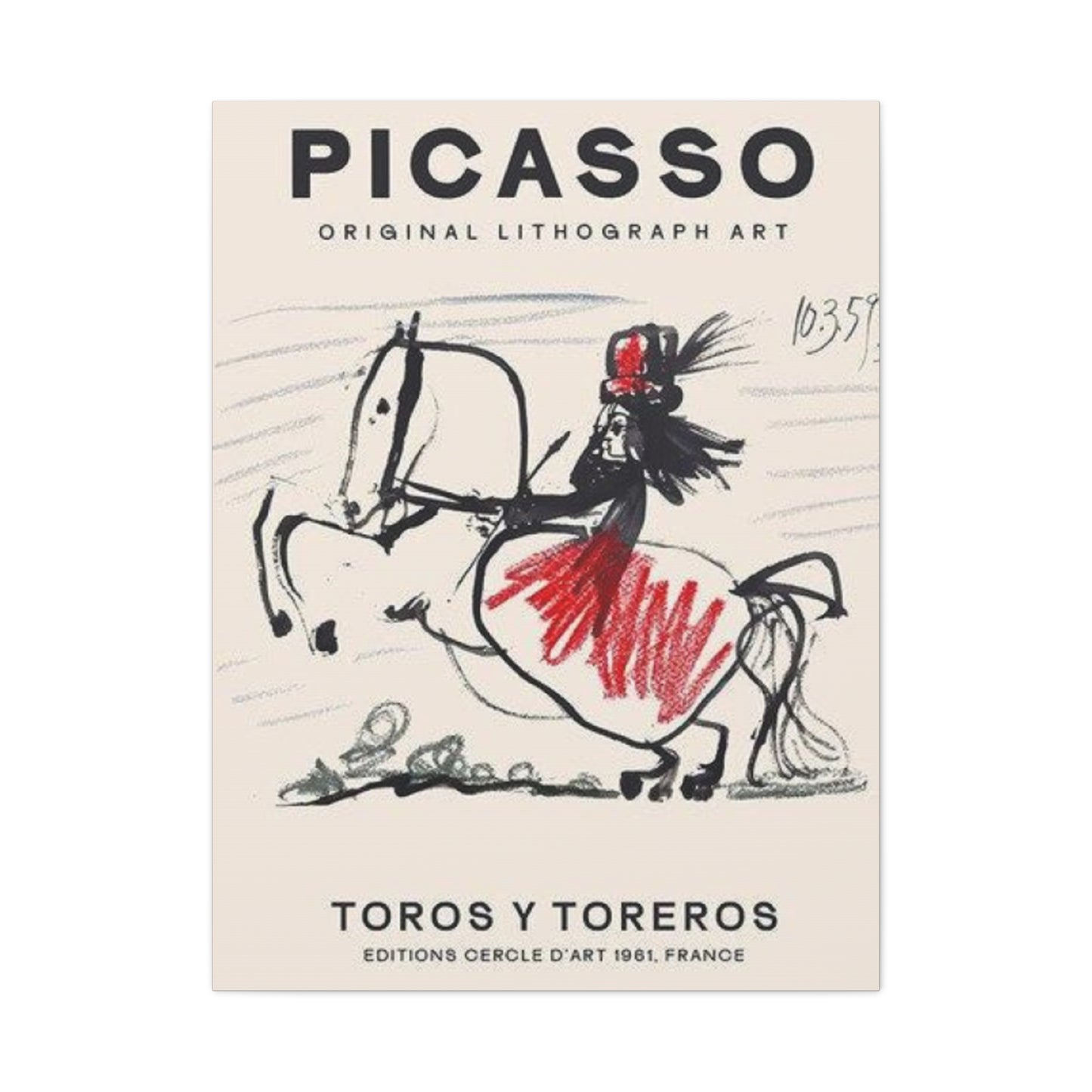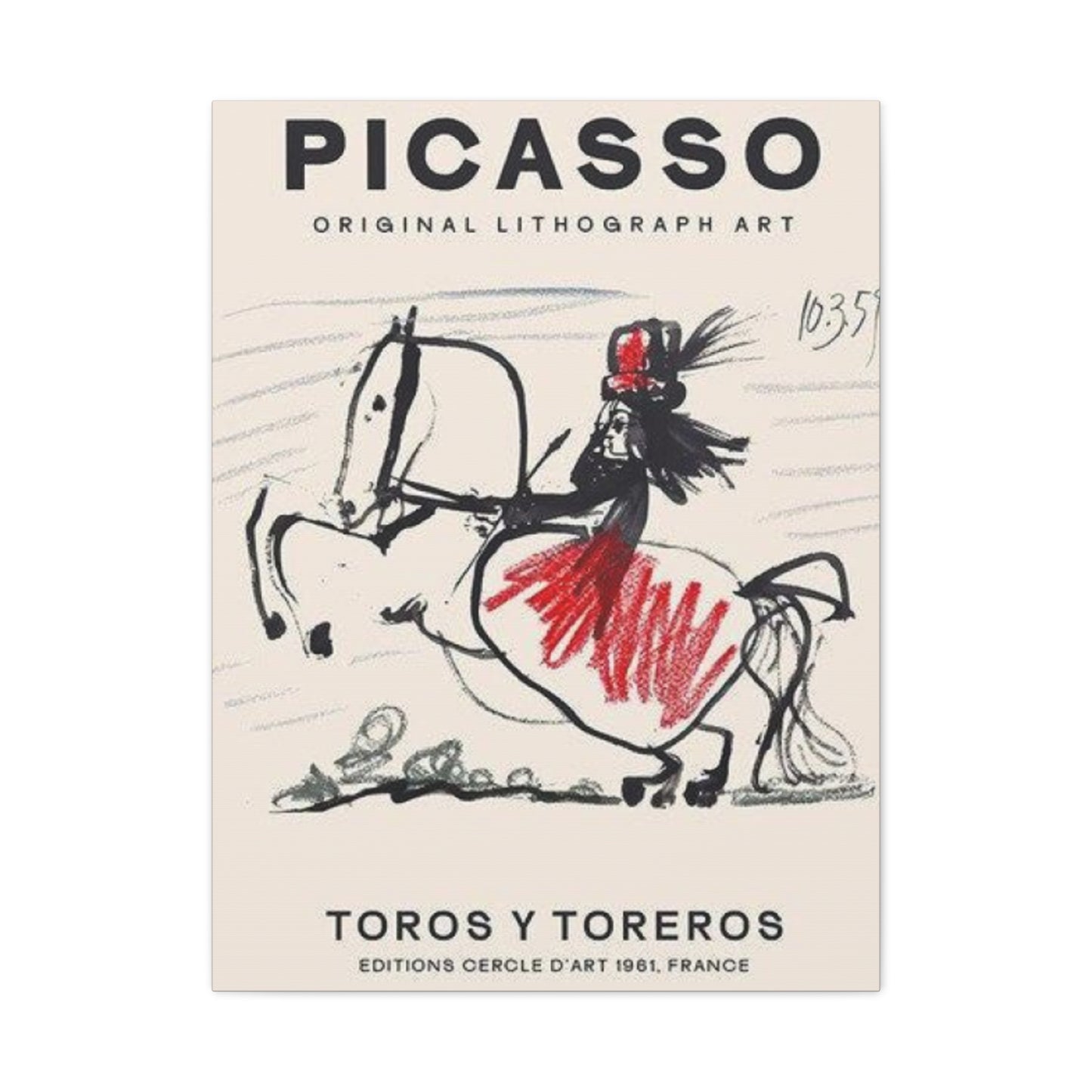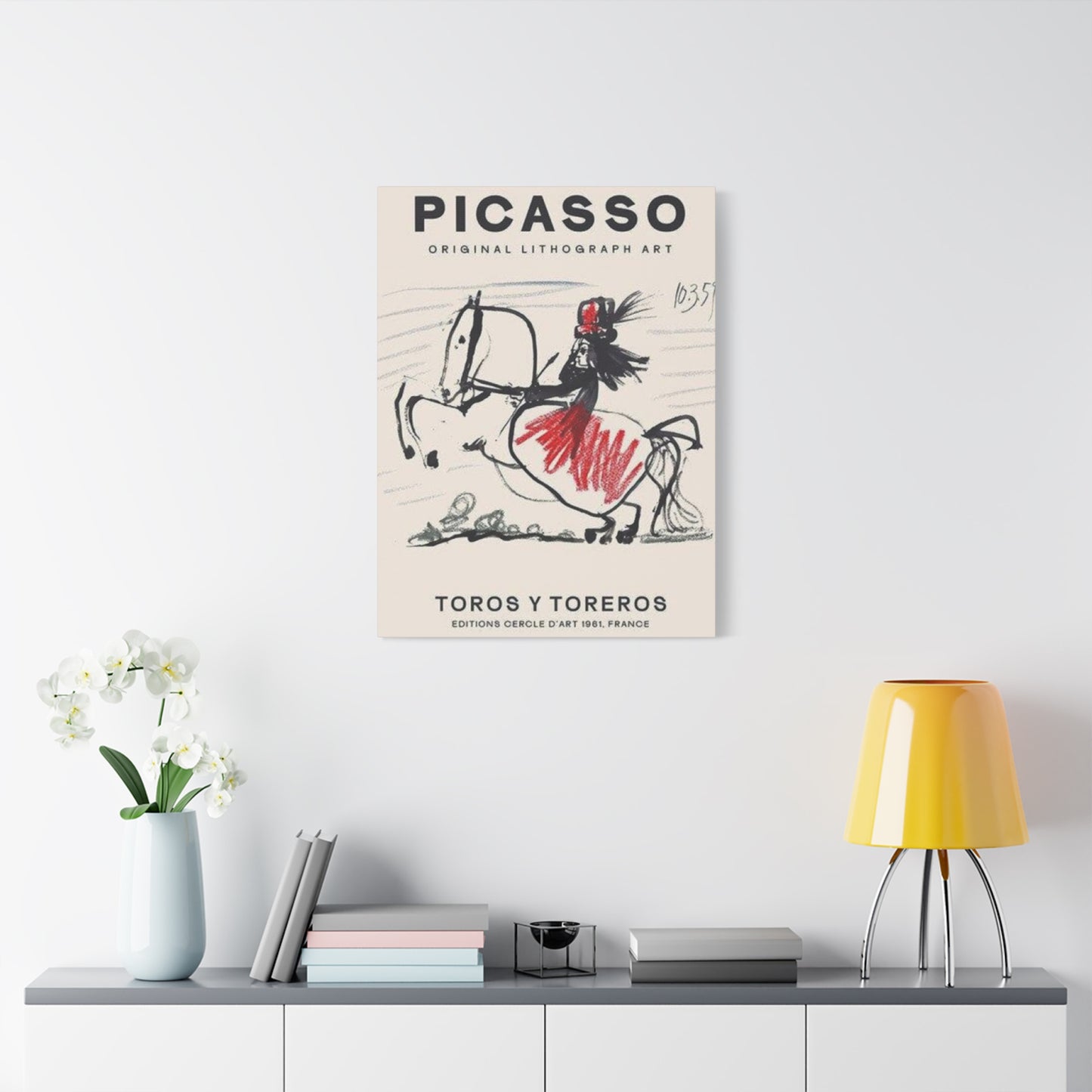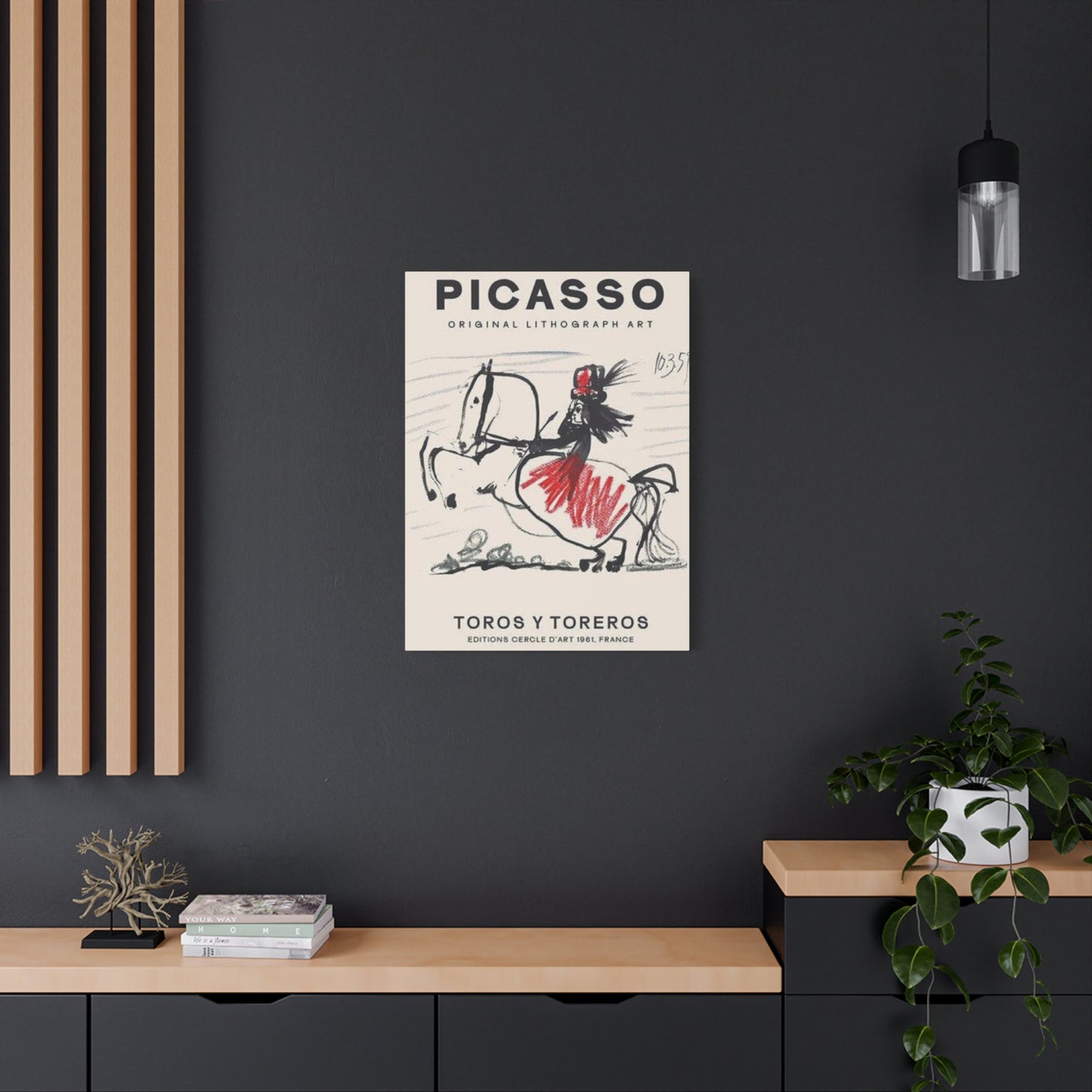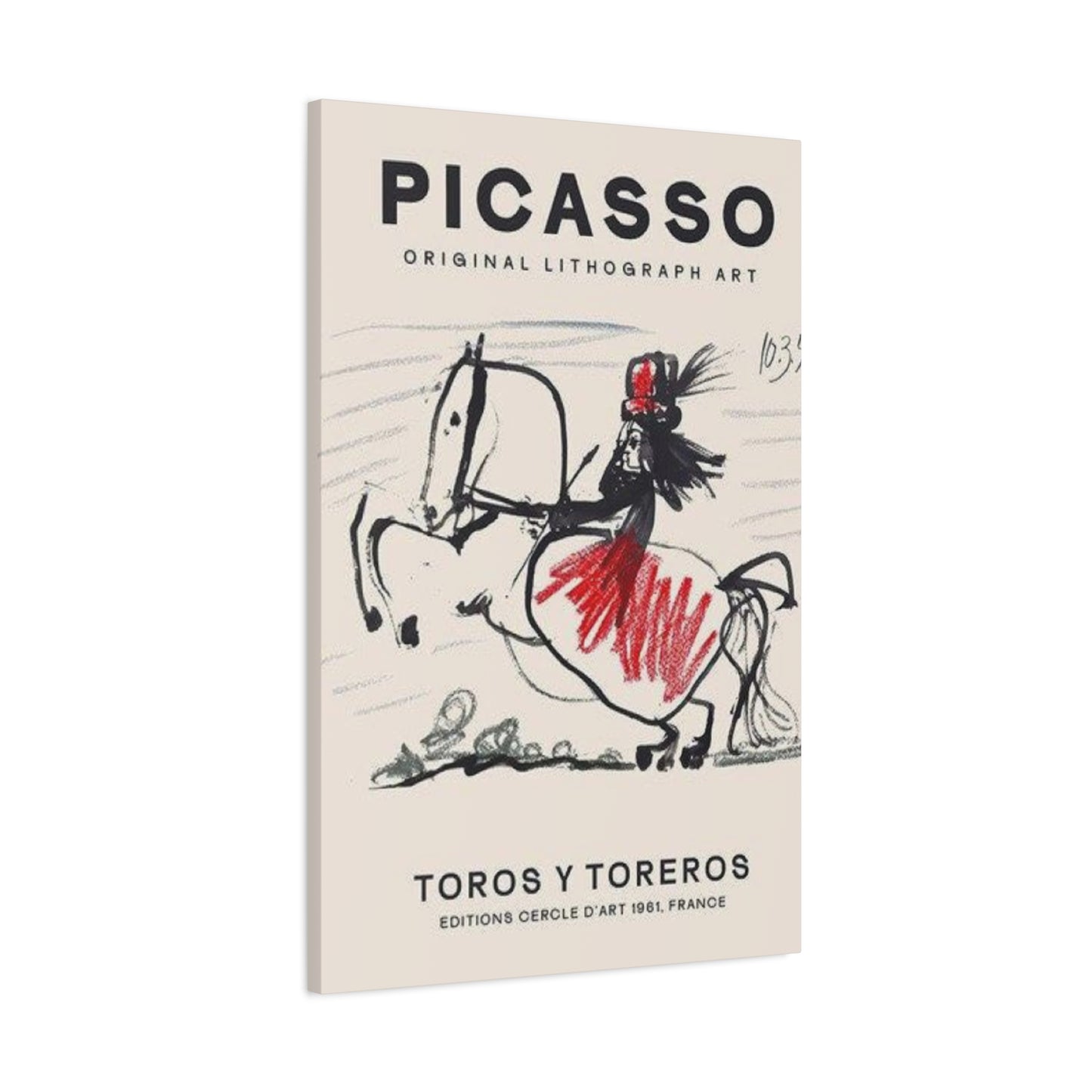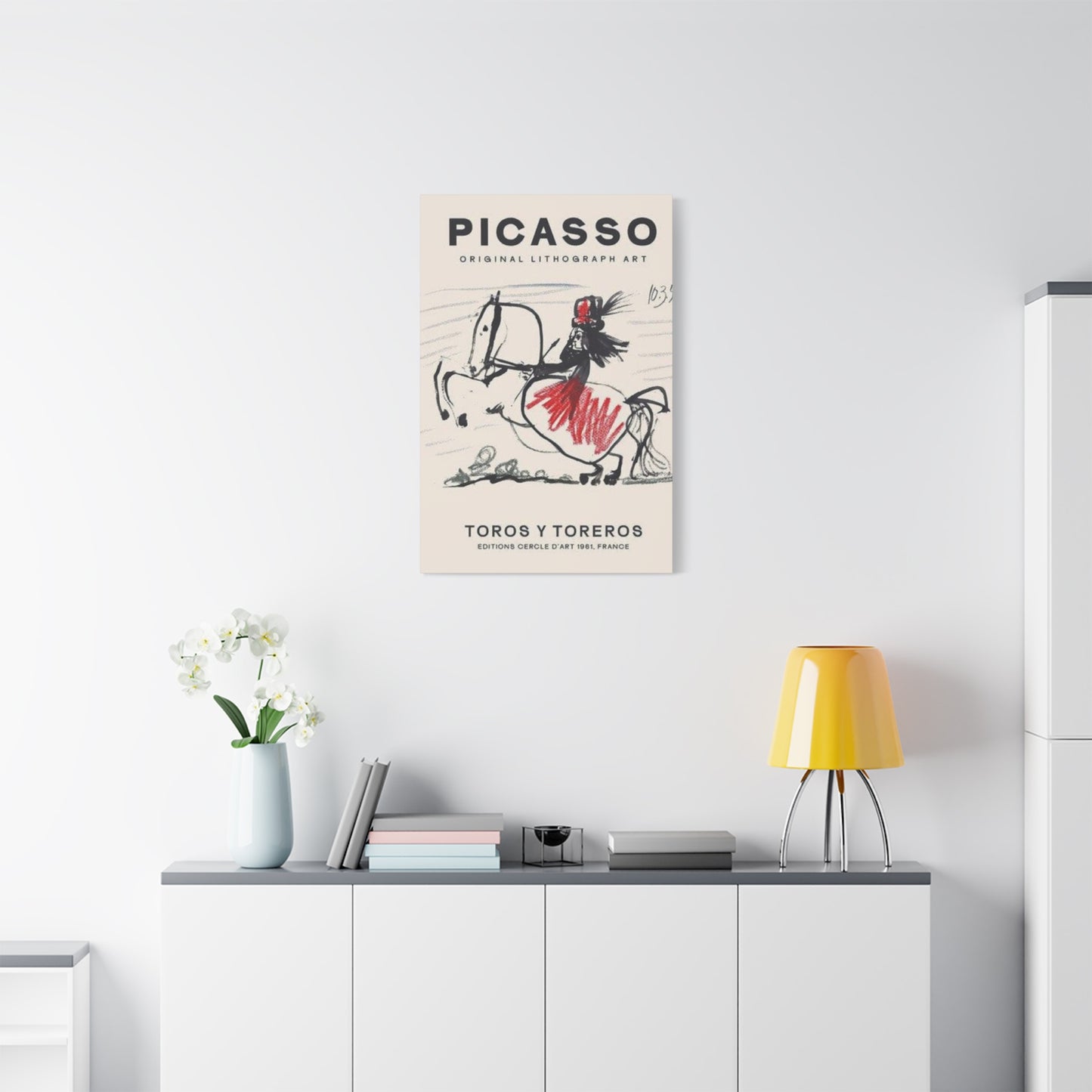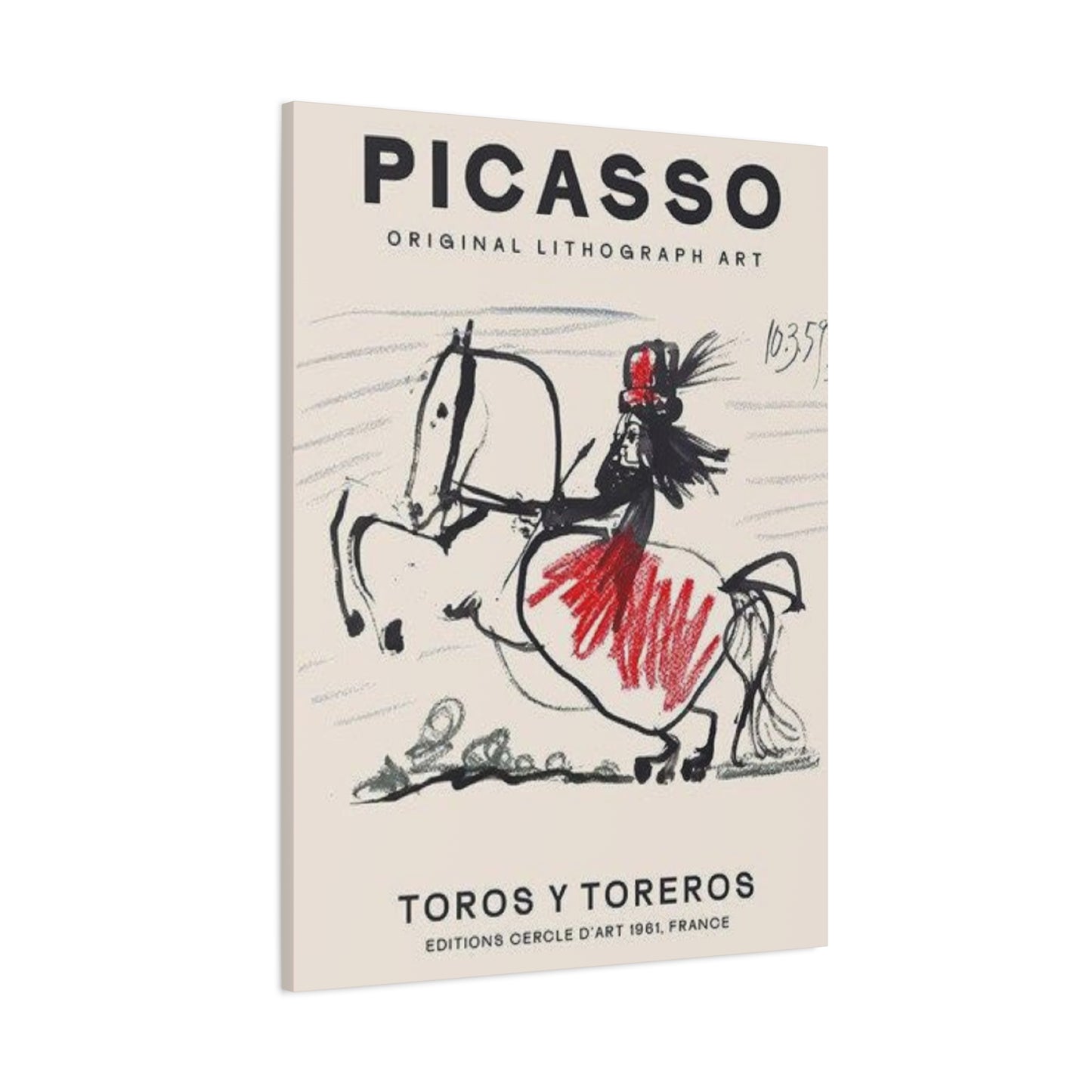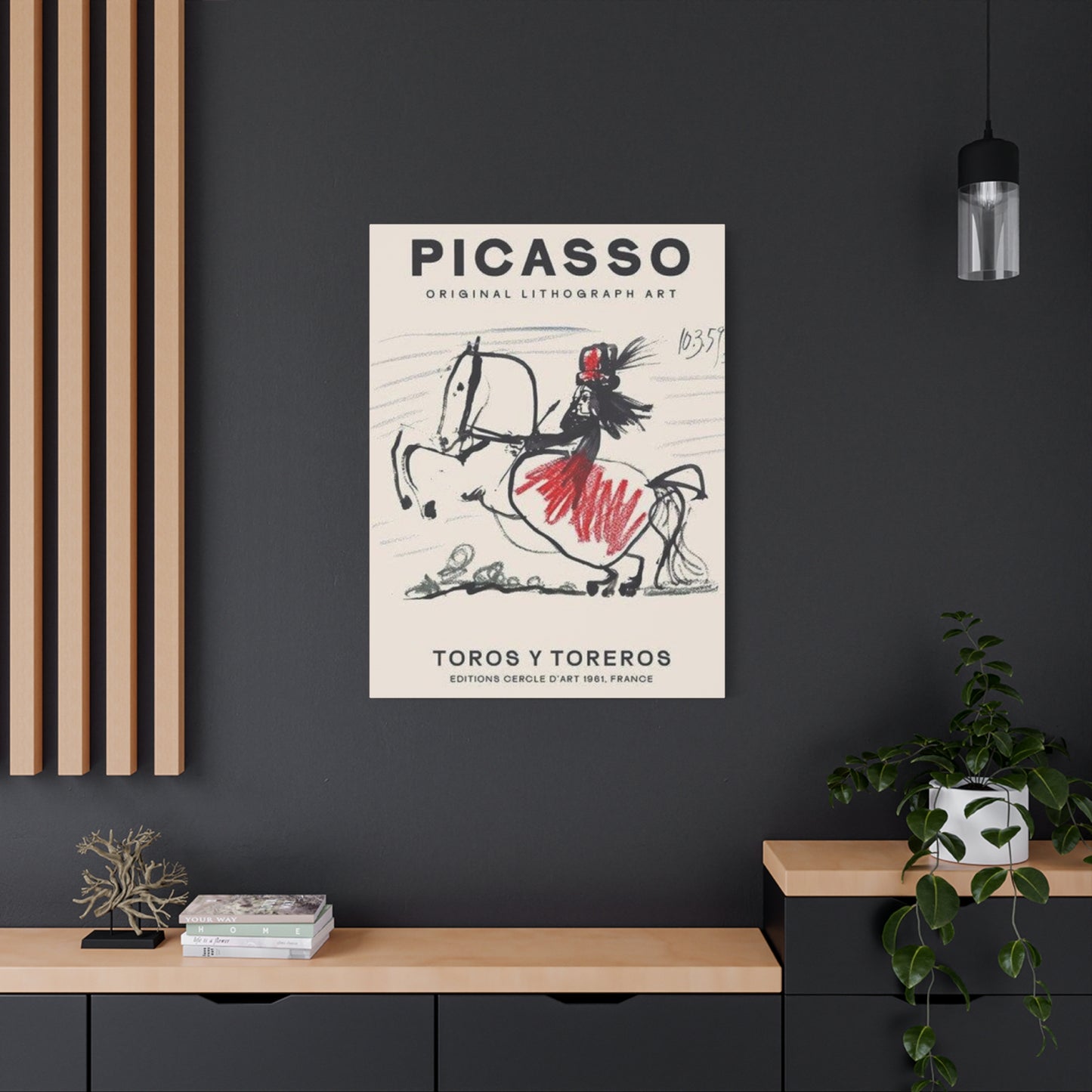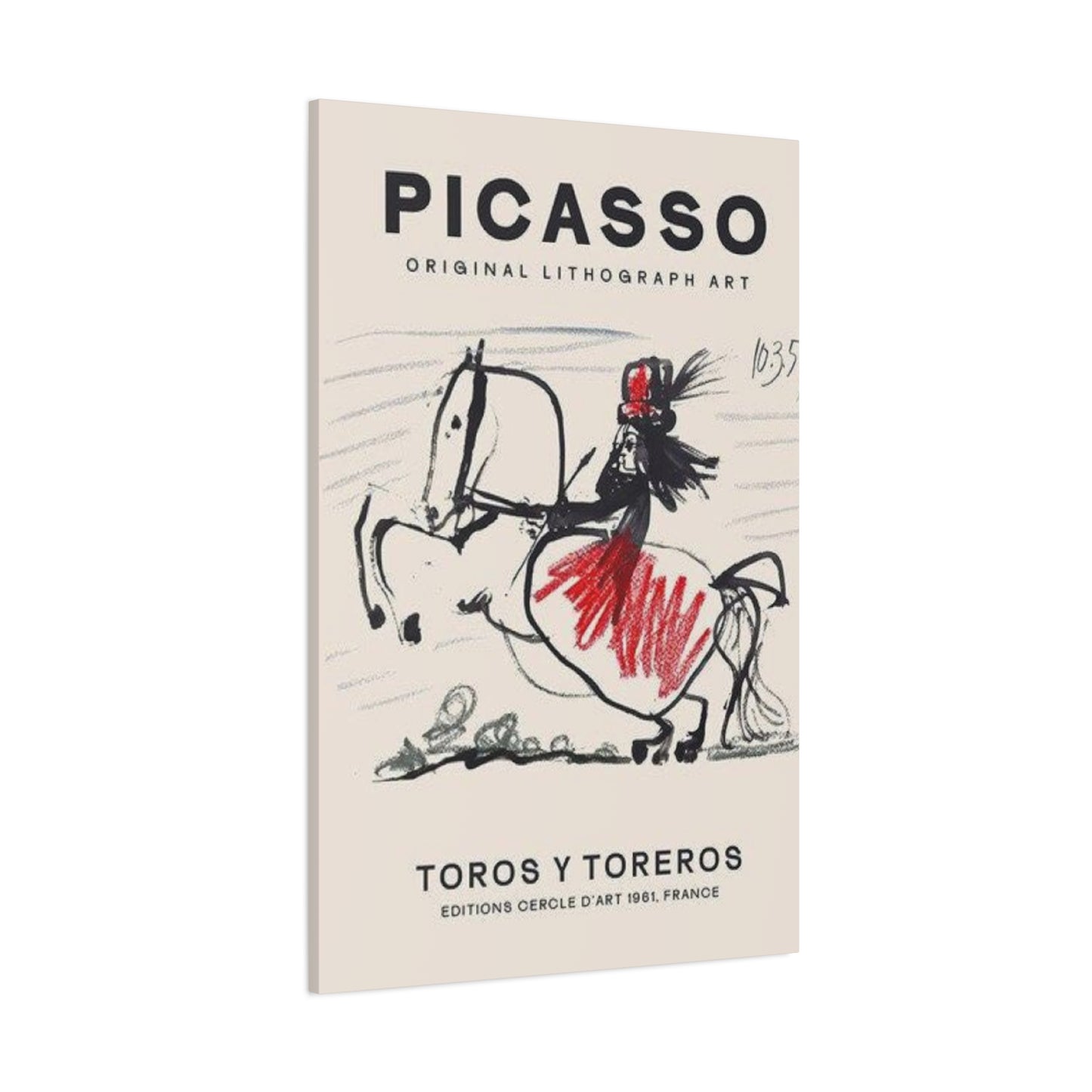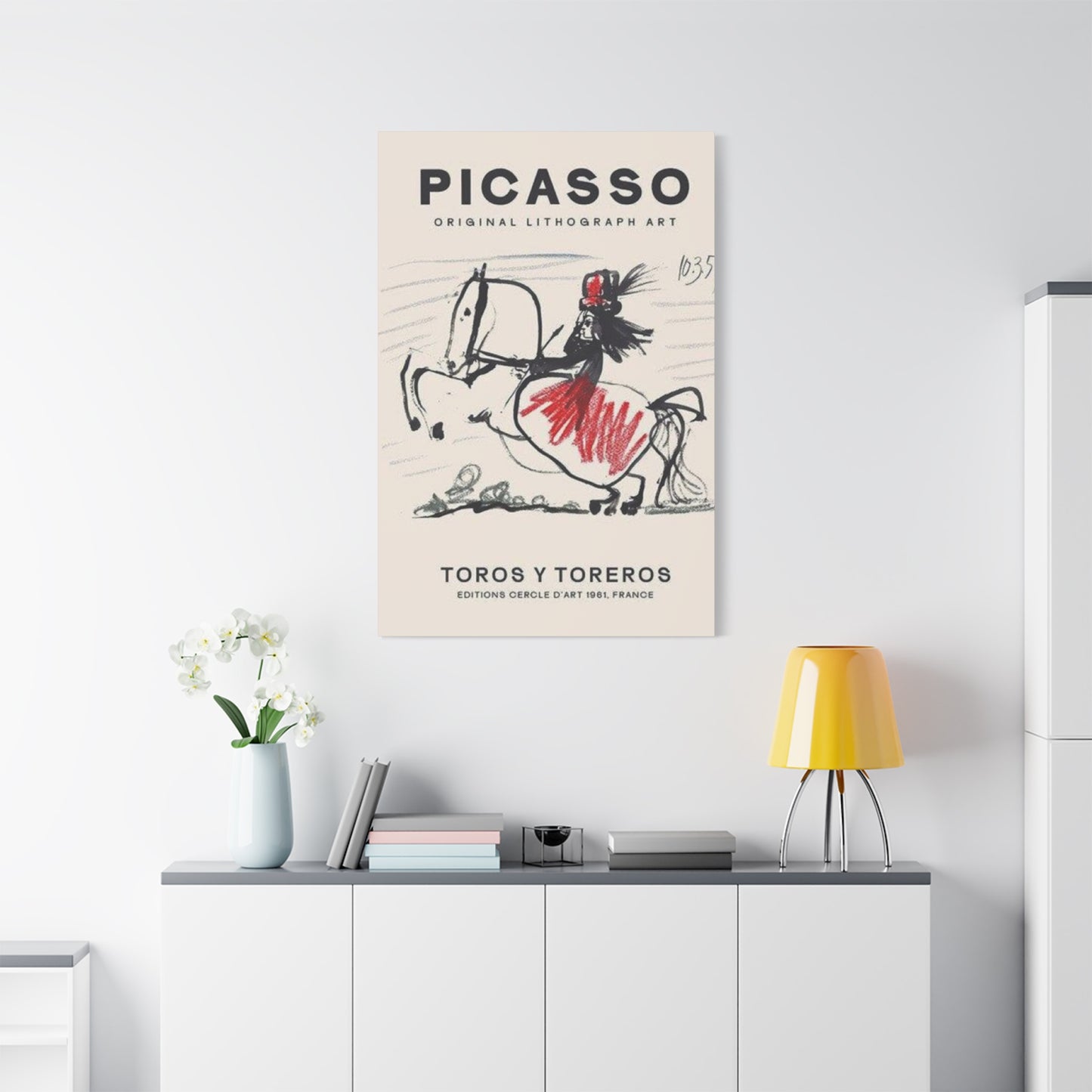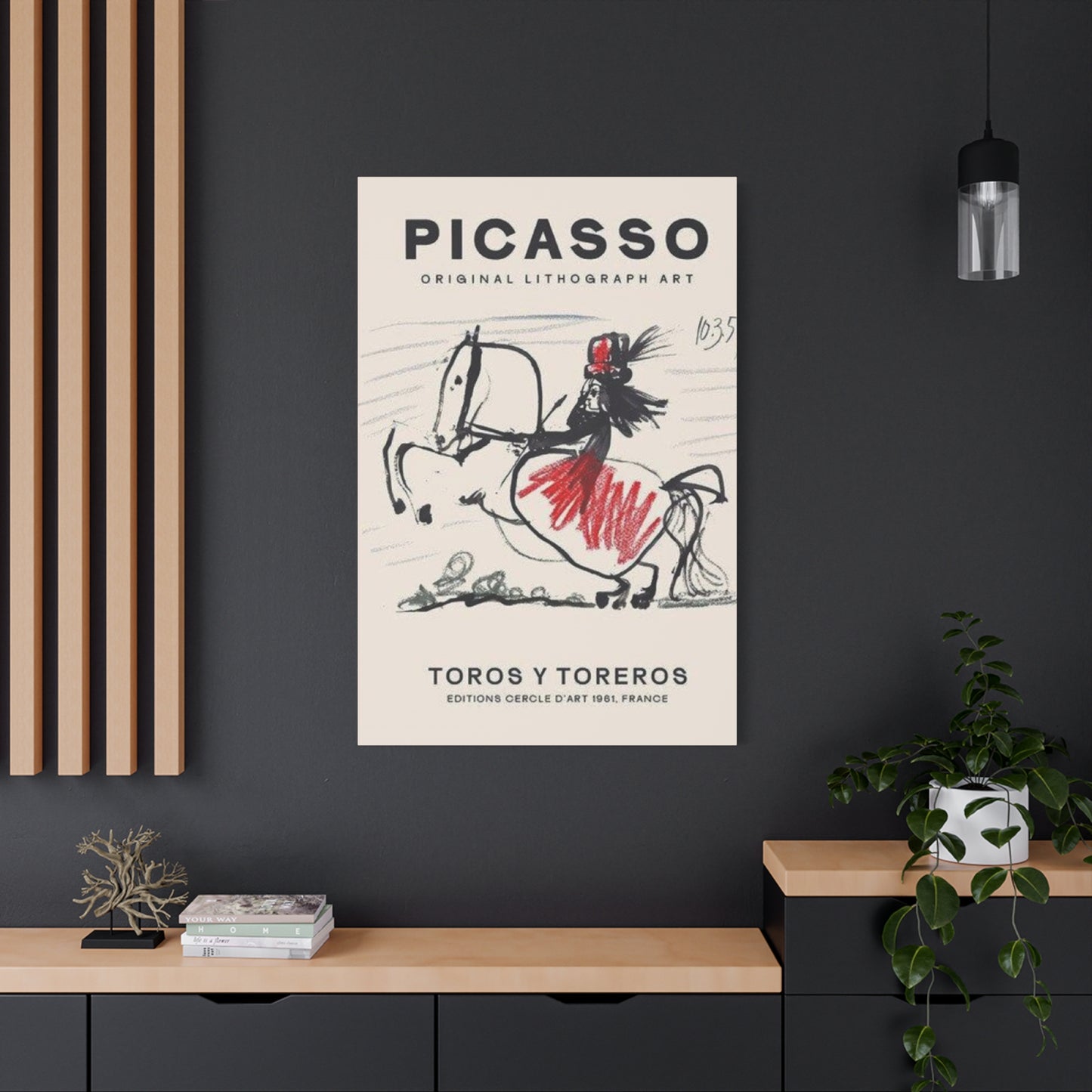Picasso Horse Riding Modernism Wall Art: Exploring the Equestrian Spirit of Modern Art
The image of a horse, captured in mid-stride or in a moment of profound suffering, is a recurring and powerful symbol within the sprawling universe of Pablo Picasso's creations. It is a motif that transcends simple representation, becoming a vessel for complex human emotions, a symbol of untamed nature, and a subject ripe for radical deconstruction. When these potent equestrian depictions are translated onto wall art canvas prints, they bring more than just decoration into a space; they carry with them the revolutionary spirit of Modernism and the unceasing energy of one of the twentieth century's most formidable creative minds. Understanding the journey of the Picasso horse, from the artist's initial sketches to its place in contemporary interior design, is to understand a pivotal chapter in the story of visual expression, one where tradition is shattered and reassembled into something startlingly new and eternally compelling. The fusion of the classical theme of horse riding with Picasso's groundbreaking approach offers a fascinating study in contrast and reinvention.
The presence of these Picasso-inspired equestrian compositions in modern homes as canvas prints signifies a deep appreciation for a transformative period in creative history. It’s an acknowledgment that a visual statement can be both historically significant and intensely personal. These prints are not mere copies; they are echoes of a seismic shift in perception, allowing the raw power of Picasso’s vision—his fragmentation of form, his bold disregard for conventional perspective, and his profound emotional depth—to resonate within a new context. The dynamic interplay between the animal's raw energy and the intellectual rigor of Modernism creates a visual tension that captivates the viewer, making these canvases a focal point of any room and a catalyst for conversation. They challenge us to see beyond the familiar and to appreciate the beauty in distortion and the truth in abstraction.
Redefining Equestrian Grace Before the Modernist Shift
Before the turn of the 20th century, the depiction of horses in art was largely governed by a commitment to realism and idealized classicism. From the majestic equestrian statues of ancient Rome celebrating emperors to the dynamic, romanticized paintings of the 19th century by artists like Théodore Géricault and Eugène Delacroix, the horse was a symbol of strength, status, and untamed natural beauty. The goal was anatomical precision, the perfect rendering of musculature, and the capturing of a heroic spirit. Artists painstakingly studied equine anatomy to ensure every sinew and every flowing mane was depicted with lifelike accuracy. In these works, the horse served as a noble companion to humanity, a vehicle for military conquest, a partner in aristocratic sport, and a powerful emblem of the wildness of nature.
Its image was inextricably linked to narratives of glory, chivalry, and social hierarchy. The smooth, polished surfaces of Neoclassical paintings and the dramatic, emotionally charged scenes of Romanticism both relied on a shared understanding of the horse as a magnificent, recognizable creature. This tradition provided a stable foundation of meaning, a universally understood language of equestrian art that had been developed over millennia. It was this very foundation of noble, realistic depiction that the pioneers of Modernism, and Picasso most ferociously among them, sought to question, deconstruct, and ultimately, obliterate, paving the way for a new, more psychologically potent vision of the equestrian form.
The Seismic Rupture of Modernism in Artistic Tradition
Modernism was not simply a new style; it was a profound philosophical and cultural revolution that tore through the established conventions of the art world. Arising from the dramatic societal shifts of the late 19th and early 20th centuries—industrialization, world wars, and groundbreaking psychological theories—Modernism rejected the long-held belief that art should be a mere imitation of reality. Artists like Picasso felt that the camera could now capture reality with perfect accuracy, so the painter’s role must evolve. Art needed to express the inner world, the subjective experience, and the fragmented nature of modern life. This led to a radical departure from traditional techniques of perspective, modeling, and composition. Instead of smooth, blended brushstrokes, artists employed bold, visible marks.
Instead of a single, coherent viewpoint, Cubism offered multiple perspectives simultaneously. Instead of realistic colors, Fauvism used color to express raw emotion. This movement was characterized by experimentation, a celebration of the abstract, and a deep-seated desire to break from the past. For the subject of the horse, this meant its form was no longer sacred. It could be flattened, fractured, distorted, and reconfigured to serve as a vehicle for ideas and emotions rather than as a simple representation of an animal. The Modernist artist was not interested in painting what a horse looked like, but rather what it felt like, what it symbolized in a chaotic new world, and how its elemental form could be used as a building block for a new artistic language.
Picasso's Deep-Seated Fascination with Equestrian Forms
Pablo Picasso’s connection to horses was deeply personal and spanned his entire, prolific career. It was a relationship forged in his Spanish homeland, a culture where the horse plays a central role in life, ritual, and spectacle. From the bullfights he witnessed as a child in Málaga to the classical sculptures he studied in his youth, the equestrian form was an ever-present force in his artistic consciousness. The bullfight, or corrida, was a particularly potent source of inspiration. In this dramatic theater of life and death, the horse was not merely a mount but a tragic figure, a vulnerable participant caught between the calculated bravery of the picador and the raw, instinctual fury of the bull.
This duality of the horse—as both a powerful, graceful animal and a symbol of innocent suffering—would become a central theme in his work. His early paintings, such as the 1906 masterpiece "Boy Leading a Horse," showcase a more classical, albeit melancholic, appreciation for the animal's form. However, as his style evolved, the horse became a recurring motif through which he could channel his most profound meditations on love, violence, myth, and war. It was a versatile symbol, a canvas upon which he could project the full spectrum of human experience. This lifelong engagement ensured that when he applied his revolutionary Modernist techniques to the horse, it was not a mere academic exercise but a deeply felt, passionate exploration of a subject that was intrinsically part of his identity.
Dismantling the Steed: The Cubist Approach to the Horse
Cubism, the revolutionary art style pioneered by Picasso and Georges Braque, was the first and perhaps most dramatic assault on the traditional equestrian image. The core principle of Cubism was to abandon the single-viewpoint perspective that had dominated Western art since the Renaissance. Instead, it aimed to represent a subject from multiple angles simultaneously, fracturing the object into geometric planes and reassembling them on the canvas. When this radical approach was applied to the horse, the result was a complete deconstruction of its familiar form. The flowing curves of the animal's neck, the powerful haunches, and the elegant head were broken down into a complex interplay of cubes, cones, and cylinders.
The sense of a solid, three-dimensional body moving through space was replaced by a flattened, fragmented, and intellectually challenging image. In works from his Cubist period, the horse loses its organic fluidity and becomes a piece of dynamic architecture. The viewer is forced to mentally reassemble the animal, engaging with the artwork not as a passive observer but as an active participant in the process of seeing. This was a profound shift. The Cubist horse was no longer a representation of a physical animal; it was an analysis of its form, a conceptual exploration of its structure, and a statement about the very nature of perception in the modern age. This approach laid the groundwork for all of Picasso’s subsequent, more emotionally charged equestrian depictions.
The Horse as a Primal Scream of Agony in Guernica
No single work better encapsulates the power of Picasso's equestrian symbolism than his monumental 1937 masterpiece, "Guernica." Painted in response to the horrific bombing of a Basque town during the Spanish Civil War, this painting is a timeless and universal protest against the brutality of war. At the very center of this chaotic, monochromatic mural is the figure of a horse, its head thrown back in a silent, agonizing scream. This is not the noble steed of classical art; it is the ultimate symbol of innocent life destroyed by mechanized violence. Its body is pierced by a spear, its mouth is open in a jagged cry of pain, and its tongue is shaped like a sharp dagger, symbolizing the sharpness of its suffering.
The animal's form is fragmented and distorted, rendered in the stark, planar style that Picasso had perfected. Here, the horse represents the voice of the people, the suffering of the defenseless caught in the crossfire of political conflict. Its terror is palpable, its agony the focal point of the entire composition. Picasso uses the horse, an animal so often associated with warfare and conquest, to subvert that very narrative. In "Guernica," the horse is not a partner in glory but the primary victim of its horror. This transformation of the equestrian symbol from a sign of power to an emblem of profound suffering is one of Picasso’s greatest contributions to art history and solidifies the horse's central role in his exploration of the darkest aspects of the human condition.
Surrealist Visions and the Equestrian Dreamscape
While Cubism deconstructed the horse's form, Surrealism allowed Picasso to explore its symbolic and psychological depths. Influenced by the psychoanalytic theories of Sigmund Freud, Surrealism sought to unlock the power of the unconscious mind, delving into the world of dreams, myths, and primal instincts. During his engagement with the Surrealist movement in the late 1920s and 1930s, Picasso's equestrian imagery became more fluid, biomorphic, and laden with complex, often unsettling symbolism. The horse began to appear in dreamlike landscapes, its form merging with other creatures or human figures in bizarre and fascinating ways. This was particularly evident in his drawings and etchings, where he could give free rein to his subconscious imagination.
The horse could represent untamed desire, primal fear, or the raw energy of the id. It was often juxtaposed with the bull, creating a powerful dichotomy of masculine and feminine principles, or of raw instinct versus suffering. In these Surrealist visions, the horse transcends its physical reality entirely, becoming a purely psychological entity. It is a creature of the mind, a specter in a dreamscape that reflects the artist's own inner turmoil and creative obsessions. This phase of his work demonstrates how the principles of Modernism allowed the horse to move beyond a subject of formal experimentation and become a deeply personal and archetypal symbol within Picasso's vast artistic vocabulary.
The Stallion and the Minotaur: A Blending of Mythologies
Picasso’s Spanish heritage instilled in him a profound connection to classical mythology, a world of gods, heroes, and monstrous hybrids that he would return to throughout his life. Two figures became particularly central to his personal mythology: the horse and the Minotaur. The Minotaur—a creature with the body of a man and the head of a bull—was, for Picasso, a potent alter ego. It represented a complex mix of virility, creativity, brutality, and shame. He often depicted this creature in his art, and frequently, the horse was its counterpart, its victim, or its ambiguous companion. In many of his etchings, particularly the famous "Vollard Suite," the horse and Minotaur engage in dramatic, often violent, confrontations.
The horse, frequently portrayed as female or mare-like, becomes a symbol of vulnerable beauty, of civilization, or of the artistic muse, while the Minotaur represents the artist’s own monstrous, creative urges. Their interactions are a complex dance of desire, conflict, and destruction. By placing the horse within this mythological framework, Picasso elevated it beyond a mere animal or a symbol of war. It became a key player in his deeply personal allegories about the nature of art, the labyrinth of the human psyche, and the tumultuous relationship between the creator and his creation. This blending of classical myth with a Modernist sensibility created a rich, multi-layered narrative that adds incredible depth to his equestrian art.
Beyond Picasso: The Equestrian Subject in Other Modernist Art
While Picasso is arguably the most famous Modernist to tackle the equestrian subject, he was not alone. Many of his contemporaries also saw the horse as a perfect vehicle for their own revolutionary ideas. The German Expressionists, for instance, used the horse to convey intense spiritual and emotional states. Franz Marc, a key member of the Blue Rider group, painted horses in vibrant, non-naturalistic colors—blue, red, and yellow—to symbolize their spiritual purity and their connection to the natural world. For Marc, the horse represented an untainted, harmonious existence that stood in stark contrast to the corruption of modern humanity.
His horses are not fragmented like Picasso’s, but they are equally divorced from realism, their forms simplified and their colors dictated by emotion. Similarly, the Italian Futurists, obsessed with speed, technology, and dynamism, depicted the horse in motion. Umberto Boccioni’s famous sculpture "Unique Forms of Continuity in Space" is an abstraction of a striding figure, but the movement and power are reminiscent of their paintings of galloping horses, where legs and bodies blur into a vortex of energy. These artists, like Picasso, understood that the horse was a powerful, archetypal image that could be loaded with new meaning. Examining their work provides a richer context for Picasso’s own achievements, showing that the drive to reinvent the equestrian form was a shared impulse among the vanguards of Modern art.
The Unbridled Energy of Line and Form in Equestrian Sketches
To truly appreciate the genius of Picasso horse riding Modernism wall art, one must look beyond his famous paintings to his vast collection of drawings, sketches, and etchings. It is in these works, often executed with a breathtaking economy of line, that his mastery of the equestrian form is most apparent. With a single, unbroken stroke of ink or charcoal, Picasso could capture the entire essence of a horse: its explosive power, its delicate grace, its raw animal spirit. These sketches are not about anatomical detail; they are about capturing motion and energy in their purest state.
He reduces the complex anatomy of the horse to its most fundamental lines and curves, demonstrating a profound understanding of the animal's structure that allowed him to abstract it so effectively. In these drawings, a few frantic scribbles can convey the chaos of a bullfight, while a simple, elegant contour can suggest the noble profile of a classical steed. This minimalist approach is a core tenet of Modernism—the idea of stripping away the non-essential to reveal a deeper truth. For collectors and enthusiasts of modern wall art, these sketches offer a more intimate and accessible entry point into Picasso's world. They showcase the raw, foundational talent that underpinned his more complex compositions and highlight the pure, unbridled energy that he found so compelling in the equestrian spirit.
Color, Emotion, and the Modernist Palette for Horses
The Modernist revolution was as much about color as it was about form. Artists broke free from the constraints of local color—the idea that an object must be painted in its naturalistic hue—and began to use color as a tool for expressing emotion and creating structure. Picasso was a master of this approach, and his use of color in his equestrian paintings is both deliberate and powerful. His early works from the Blue and Rose Periods use color to establish an overarching mood of melancholy or gentle optimism. Later, in "Guernica," he famously eschewed color entirely, opting for a stark, monochromatic palette of black, white, and grey.
This deliberate absence of color functions like a news report, emphasizing the grim, objective horror of the event and heightening the emotional impact of the scene. It forces the viewer to focus on the raw power of the forms and the agony they convey. In other works, however, he might use a splash of vibrant, arbitrary color to draw attention to a particular part of the horse or to infuse the scene with a specific feeling, be it passion, jealousy, or joy. For those looking to incorporate Picasso-inspired art into their homes, understanding this use of color is key. A monochromatic piece can create a sophisticated, dramatic focal point, while a work with bold, expressive colors can inject energy and emotion into a space, demonstrating that for Modernists, color was not for describing but for feeling.
Transforming Masterpieces into Contemporary Wall Decor
The enduring appeal of Picasso's work, particularly his powerful equestrian themes, has made it a popular and sophisticated choice for modern interior design. Bringing a piece of Picasso horse riding Modernism wall art into a home is about more than just filling a space; it's about making a statement. This style of art speaks to a taste for history, a comfort with intellectual challenge, and an appreciation for bold, expressive forms. The abstract and often fragmented nature of these pieces means they can integrate seamlessly into a variety of decor styles, from minimalist to industrial to eclectic. In a minimalist setting, a single, powerful line drawing of a horse can serve as a stunning focal point without overwhelming the space.
In a more industrial or rustic environment, a large canvas print of a more complex, Cubist-inspired work can complement the raw textures of brick and metal. The key to successfully incorporating this art is to treat it as a central element of the design. It is not background decoration. Its dynamic energy and historical weight demand attention. By choosing a piece that resonates on a personal level and giving it the prominence it deserves, you can transform a simple room into a sophisticated gallery-like space that sparks conversation and reflects a deep appreciation for one of the most transformative periods in art history.
Selecting Your Picasso-Inspired Equestrian Artwork
Choosing the right piece of Picasso-inspired equestrian wall art for your space requires a thoughtful consideration of both the art itself and the environment it will inhabit. First, consider the emotional tone you wish to set. Are you drawn to the raw power and agony of his "Guernica"-style horses, which would create a dramatic and thought-provoking atmosphere? Or do you prefer the simpler, more graceful lines of his neoclassical-inspired sketches, which can evoke a sense of calm and classicism? The vast range of his equestrian work offers a wide spectrum of moods. Next, think about the style.
A highly fragmented Cubist piece is intellectually stimulating and makes a bold, modern statement. A more fluid, Surrealist-inspired work might be better suited for a space meant for creativity and contemplation. Consider the color palette of your room. A monochromatic piece can provide a stunning contrast in a colorful room or harmonize beautifully with a neutral scheme. Conversely, a piece with bold colors can be the perfect element to tie together a room's various color accents. Finally, consider the narrative. Do you connect with the mythological themes, the bullfighting drama, or the simple, pure depiction of the animal? Choosing a piece whose story resonates with you will ensure that it remains a cherished and meaningful part of your home for years to come.
The Crucial Impact of Scale and Placement in Home Design
Once you have selected your ideal piece of Picasso horse riding Modernism wall art, its impact on your space will be largely determined by two critical factors: scale and placement. The scale of the artwork should be in proportion to the wall and the surrounding furniture. A common design mistake is to hang a piece that is too small for the wall, making it feel lost and insignificant. For a large, empty wall, such as behind a sofa or in a dining room, don't be afraid to choose a large, statement-making canvas. A grandly scaled piece can anchor the entire room and create a powerful focal point. Conversely, a collection of smaller sketches can be grouped together to create a gallery wall, which can have just as much impact as a single large piece. Placement is equally important.
The standard gallery rule is to hang art so that its center is at eye level, which is typically around 57-60 inches from the floor. This creates a comfortable and natural viewing experience. Consider the lines of sight in the room. Placing a compelling piece at the end of a hallway or directly opposite the entrance to a room can create immediate drama and draw visitors into the space. Don't be afraid to experiment by leaning a piece against a wall on a credenza or a mantle for a more casual, layered look. Thoughtful consideration of scale and placement will elevate your chosen artwork from a simple accessory to an integral component of your home's design.
Exploring Materiality: From Canvas Prints to Metal Art
The medium on which your Picasso-inspired art is presented can dramatically alter its look and feel, adding another layer of texture and personality to your decor. The most traditional choice is a high-quality giclée print on canvas. A stretched canvas provides a classic, painterly feel that honors the original medium of many of Picasso's masterpieces. You can choose a gallery wrap, where the image extends around the sides for a clean, modern look, or frame it for a more traditional and polished presentation. Another popular option is a framed paper print, often under glass.
This can lend a more formal, graphic quality to the artwork, which works particularly well for his line drawings and sketches. For a truly contemporary and industrial aesthetic, consider having the image printed on metal, such as aluminum. Metal prints offer vibrant colors and a sleek, high-gloss finish that can make the artwork pop with incredible clarity and depth. The frameless nature of metal art enhances its modern appeal. Another option is acrylic, where the print is face-mounted to a piece of clear acrylic, giving it a luminous, almost three-dimensional quality. Each material interacts with light differently and brings its own unique character to the artwork. The choice depends on your personal style and the overall aesthetic of your space, whether you are aiming for classic elegance, graphic modernity, or industrial chic.
Designing a Thematic Gallery Wall with Modernist Equestrian Art
Creating a gallery wall is a wonderful way to display a collection of smaller pieces and tell a more expansive visual story. A gallery wall themed around Modernist equestrian art can be particularly stunning and intellectually engaging. The key to a successful gallery wall is to find a balance between cohesion and variety. You can achieve cohesion by sticking to a central theme—in this case, the Modernist horse—but introduce variety through different artists, styles, and mediums. For instance, you could center the collection around a medium-sized Cubist horse print.
Then, you could surround it with smaller, simpler Picasso line drawings, a colorful abstract equestrian piece by another artist like Franz Marc, and perhaps even a black-and-white photograph of a horse that echoes the abstract forms in the paintings. Varying the frame styles and colors can also add visual interest, though keeping them all within a similar family (e.g., all black frames or all natural wood frames) can help unify the collection. Before hammering any nails, lay out your arrangement on the floor to experiment with spacing and balance. A thematic gallery wall like this does more than just decorate a space; it creates a curated visual narrative, transforming your wall into a miniature museum dedicated to the revolutionary spirit of Modern art.
Powerful Legacy of Picasso's Equestrian Vision
The influence of Pablo Picasso's equestrian art extends far beyond the confines of museums and galleries; it has fundamentally altered the way subsequent generations of artists have approached the animal form. By shattering the horse's classical image, Picasso liberated it from its purely representational function. He demonstrated that an animal's form could be a powerful conduit for the entire spectrum of human emotion, from profound suffering to unbridled passion. This legacy can be seen in the work of countless artists who followed. Abstract Expressionists like Willem de Kooning, with his frantic, deconstructed "Woman" series, clearly drew from Picasso's violent fragmentation of form.
The raw, expressive energy of artists like Jean-Michel Basquiat, with his graffiti-inspired, symbolic imagery, owes a debt to Picasso's use of primal, archetypal figures. Even today, contemporary artists who depict animals often do so with a conceptual or emotional depth that would have been unthinkable before Picasso broke down the barriers of realism. He gave artists permission to distort, to abstract, and to imbue their subjects with complex psychological meaning. His horses, in all their fragmented glory and agony, continue to serve as a benchmark for expressive power, reminding us that the true subject of great art is never just the object being depicted, but the vast, turbulent landscape of the human soul.
Abstract Equestrian Art in a Living Space
Introducing abstract art, especially pieces with the emotional weight of Picasso's equestrian work, into a living space can have a profound psychological impact. Unlike realistic art, which presents a clear and easily digestible image, abstract art requires the viewer to participate in the creation of meaning. A fragmented Cubist horse or a screaming head from "Guernica" challenges our perceptions and invites interpretation. This act of engagement can be incredibly stimulating, turning a passive space into an active environment for thought and reflection. The raw emotion conveyed in these works can also resonate on a subconscious level.
The power and suffering embodied in Picasso's horses can evoke feelings of strength, resilience, or empathy, depending on the viewer's own experiences and mindset. For some, the chaotic energy of a Cubist piece can be invigorating and inspiring, a visual representation of creative thinking. For others, the stark simplicity of a line drawing can provide a sense of calm and focus. This art doesn't just decorate a room; it infuses it with a complex emotional and intellectual character. It can serve as a daily reminder of the power of art to express the inexpressible and to challenge us to see the world not just as it is, but as it is felt and perceived through the kaleidoscopic lens of human consciousness.
Navigating Authenticity and Inspired Pieces in Modern Decor
When seeking to bring the spirit of Picasso horse riding Modernism wall art into your home, it's important to understand the distinction between authentic, licensed reproductions and pieces that are merely "inspired by" the artist's style. Authentic reproductions are high-quality prints authorized by the Picasso estate or the museums that hold the original works. These pieces are created with great care to accurately replicate the colors, details, and scale of the original painting or drawing. While they are not original works themselves, they carry a stamp of legitimacy and are the most faithful way to enjoy these masterpieces in your own home. On the other hand, the market is also filled with art that is "Picasso-inspired."
This can range from works by talented contemporary artists who are exploring Cubist or Modernist themes in their own unique way, to mass-produced decorative items that mimic his style without capturing its depth. There is a place for both in home decor. An inspired piece can be a more affordable way to capture the aesthetic and mood of Picasso's work without being a direct copy. When choosing, the key is transparency and personal taste. If you value the historical and artistic integrity, seek out licensed reproductions. If you are more interested in the overall style and aesthetic, an inspired piece by a contemporary artist can be a wonderful and original choice that still pays homage to the master's revolutionary vision.
Synthesizing Motion, Myth, and Modernity in Art
The enduring power of Picasso's equestrian art lies in its incredible synthesis of disparate, powerful concepts. In his hands, the horse is simultaneously a creature of flesh and blood, a symbol from ancient myth, and a vehicle for the most radical artistic ideas of the modern age. He captures the kinetic energy of horse riding—the thunder of hooves, the powerful arch of a neck—and filters it through the fractured, multi-dimensional lens of Cubism. He reaches back into the mists of mythology, summoning the tragic power of the steeds in Greek tragedies and the primal force of the centaur, and re-presents these ideas in a visual language that is starkly, uncompromisingly modern.
This is the essence of his genius: the ability to hold multiple, seemingly contradictory ideas in perfect tension within a single image. A Picasso horse is never just one thing. It is a symbol of suffering innocence in "Guernica," a player in a mythological drama alongside the Minotaur, and a formal exercise in the deconstruction of form. When we choose to display Picasso horse riding Modernism wall art, we are inviting this complex synthesis into our daily lives. We are choosing a piece of art that embodies the collision of past and present, the fusion of raw emotion with intellectual rigor, and the timeless story of an artist who took one of history's most noble symbols and remade it in the image of a chaotic, challenging, and profoundly beautiful new world.
Reflection on a Timeless Artistic Vision
In conclusion, the journey through the world of Picasso horse riding Modernism wall art is an exploration of one of the most dynamic and revolutionary chapters in the history of human creativity. It is a testament to how a single, recurring motif—the horse—can be endlessly reinvented to express the evolving consciousness of an era. We began by understanding the classical and romantic traditions that Picasso so brilliantly subverted, where the horse was a symbol of idealized power and beauty. We then witnessed the seismic shift of Modernism, which prioritized subjective experience and emotional truth over objective reality, setting the stage for Picasso’s radical experiments. His deep, personal connection to the equestrian world, born from the culture of his native Spain, provided the emotional fuel for his artistic fire.
Through the intellectual rigor of Cubism, he dismantled the horse’s physical form, forcing us to see it not as a single entity but as a composite of multiple perspectives. In his masterpiece, "Guernica," he weaponized this fragmented form, transforming the horse into the ultimate emblem of innocent suffering, a universal scream against the horrors of war that still reverberates today. His engagement with Surrealism and mythology further deepened the horse's symbolic power, turning it into a creature of dreams and a key player in his personal allegories of creativity and desire. By examining his singular focus on line and his strategic use of color, we appreciate the technical mastery that underpinned his expressive power. For the modern homeowner, this rich legacy offers more than just decoration. It presents an opportunity to engage with art that is intellectually stimulating, emotionally resonant, and historically significant.
Unbridling Tradition: The Horse in Picasso’s Visual Language
Throughout Pablo Picasso's extensive career, the horse appears not as a monolithic symbol but as a multifaceted character with a shifting role. In his earlier periods, the creature is often depicted with a degree of classical grace, reminiscent of the noble steeds in the works of Spanish masters like Velázquez and Goya, who deeply influenced him. We see them in circus scenes and among bullfighting pageantry, captured with a certain romanticism. However, as Picasso’s personal style evolved and he began to dismantle the established norms of representation, the horse transformed. It became a screen upon which he projected the anxieties, passions, and brutalities of the human condition. The refined creature of the past was systematically broken down and re-forged through the prism of his innovative perspectives.
The most iconic and harrowing depiction is undoubtedly the screaming horse in his monumental anti-war statement, Guernica. Here, the animal is not a symbol of strength or nobility but the ultimate victim, a figure of pure agony. Its head is thrown back, its mouth is open in a silent shriek, and a dagger-like tongue juts out, encapsulating the senseless suffering of the innocent during the bombing. This horse is a universal emblem of torment. In his Cubist phases, the horse was often fractured into geometric planes, its anatomy reconfigured to be seen from multiple viewpoints simultaneously. This was not a pursuit of realism but an exploration of the very essence of the form, a cerebral exercise that challenged the viewer's perception of reality. By dissecting the horse's shape, Picasso invited a deeper engagement with the subject, moving beyond its physical appearance to its conceptual foundation.
A Modernist Charge: Reimagining Equestrian Subjects
Modernism was a radical departure from the representational mandates of the past. It was a movement fueled by a desire to invent new visual languages to describe a rapidly changing world. A classical subject like horse riding, traditionally associated with power, heroism, and aristocratic leisure, became a perfect candidate for this revolutionary reinterpretation. In the hands of a modernist like Picasso, the theme was stripped of its conventional narrative and imbued with a new, often unsettling, psychological and formal intensity. Instead of celebrating the harmonious partnership between rider and mount, Picasso's compositions often explore a more elemental or fractured relationship, reflecting a world where old certainties were collapsing.
The modernist approach, particularly Cubism, which Picasso co-founded, was about seeing the world not as a fixed, single image but as a composite of shifting perspectives and underlying structures. When applied to the dynamic motion of a horse and rider, this resulted in compositions of explosive energy. The fluid movement of the gallop was frozen and shattered into a crystalline structure of interlocking shapes and lines. Color was often used not for its descriptive accuracy but for its emotional impact, with somber palettes of grays, blacks, and ochres conveying a serious, introspective mood, or jarring, discordant hues suggesting chaos and conflict. This reimagining was not an act of destruction but one of profound analysis. It was a way of conveying the speed, power, and vitality of the equestrian subject in a manner that a purely naturalistic rendering could not. These pieces communicate the experience of the motion, not just its appearance, making them profoundly modern visual documents.
The Anatomy of a New Vision: Picasso's Stylistic Revolution
At the heart of Picasso’s enduring influence is his relentless experimentation with form and perspective. He famously stated that he did not seek, but found. His process was one of constant discovery, and the horse provided a familiar framework upon which he could build his most audacious structural innovations. His Cubist period, with its analytical and synthetic phases, is central to this. In Analytical Cubism, he would deconstruct the horse into a series of geometric facets, rendered in a muted color palette to emphasize its structure. The viewer is presented with a complex puzzle of planes and angles, yet the essential "horseness" of the subject remains uncannily intact. It is a visual dissection that reveals a deeper truth about the object's presence in space.
Later, in Synthetic Cubism, the approach shifted. Instead of breaking the subject down, Picasso began to build it up from flat, distinct shapes, almost like a collage. A simplified curve might signify the horse's neck, a sharp triangle its ear, and a bold, flat plane its powerful flank. This method allowed for greater expressive freedom and a more direct, almost symbolic, form of communication. Beyond Cubism, Surrealist influences also permeated his work. The horses in some of his later compositions take on dreamlike, almost mythological qualities. They appear in ambiguous settings, their bodies distorted in ways that suggest subconscious fears or desires. Through these varied stylistic explorations, Picasso demonstrated that a subject as old as civilization itself could be a conduit for the most advanced and forward-thinking creative ideas of his time, forever changing how we perceive form, space, and motion.
From Studio to Sitting Room: The Journey to Canvas Prints
The transformation of a seminal Picasso composition into a high-quality wall art canvas print is a journey that bridges the gap between the hallowed halls of a museum and the intimate spaces of a home. This process makes some of the most significant visual statements of the twentieth century accessible to a broader audience, allowing individuals to curate their own environments with pieces of profound historical and personal resonance. A canvas print offers a textural quality that differs from a simple paper poster; the weave of the canvas lends a certain depth and material presence to the image, creating a closer connection to the physicality of an original painting. This format is particularly well-suited to Picasso’s equestrian renderings, as the robust texture of the canvas complements the raw, powerful energy of his lines and forms.
When selecting a Picasso-inspired canvas for home decor, one is not merely choosing a picture but engaging with a legacy. The choice of a particular piece—be it a fragmented Cubist horse, a sorrowful figure from the Guernica studies, or a more playful, linear sketch—can dramatically influence the atmosphere of a room. A large, monochromatic canvas of the screaming horse can serve as a dramatic, thought-provoking centerpiece in a minimalist setting, while a smaller, more colorful depiction from a different period might add a vibrant, dynamic accent to a more eclectic space. The durability and frameless presentation of many modern canvas prints also align with contemporary design sensibilities, allowing the composition itself to take center stage without the formal barrier of a traditional frame. It is a modern way to live with a modern master, integrating his revolutionary vision seamlessly into the fabric of daily life.
Curating Your Space with Modernist Energy
Integrating a canvas print of a Picasso horse into your interior design is a deliberate act of cultural and aesthetic alignment. It is a choice that speaks to a taste for the bold, the intellectually stimulating, and the historically significant. To do so effectively requires consideration of the surrounding environment. In a space defined by clean lines, neutral colors, and minimalist furnishings, a complex Cubist composition can act as a powerful focal point, introducing intricate geometry and intellectual depth without overwhelming the senses. The typically subdued palette of early Cubism—grays, beiges, and blacks—can harmonize beautifully with modern industrial or Scandinavian design schemes.
For more traditional or transitional interiors, a piece from Picasso’s more neo-classical or linear periods might be more appropriate. A simple, elegant line drawing of a horse and rider on canvas can introduce a touch of modernist grace without creating a stark contrast with classic furniture. The key is to create a dialogue between the visual statement on the wall and the room it inhabits. Consider the scale of the print; a large, oversized canvas can command a living room or entryway, making a confident and dramatic statement. A series of smaller canvases, perhaps studies or variations on the equestrian theme, can create a sophisticated gallery wall in a study or hallway. Ultimately, bringing a Picasso horse into your home is about more than just filling a blank wall; it is about infusing your personal space with a spark of creative genius and the unyielding spirit of the modernist revolution.
Resonance of a Fractured Form
Why, after so many decades, does Picasso’s vision of the horse continue to captivate and provoke? The answer lies in its profound duality. His equestrian compositions are at once specific and universal, ancient and startlingly modern. The horse is an archetypal symbol, representing concepts that have resonated with humanity for millennia: freedom, power, nature, and companionship in struggle. Picasso taps into this deep well of collective understanding. Yet, he presents this familiar subject through a visual vocabulary that was, and still is, revolutionary. His fragmentation of form mirrors the fractured nature of modern consciousness, and his emotional intensity speaks to timeless human experiences of joy, suffering, passion, and conflict.
The enduring appeal of these pieces as wall art canvas prints stems from this powerful combination. They are not passive, decorative images. They are active, challenging compositions that demand engagement from the viewer. They spark curiosity, invite interpretation, and can sustain interest over many years. A Picasso horse on a wall is a constant reminder of the power of creativity to reinterpret the world and to find profound meaning in the deconstruction of the familiar. It represents the courage to break with tradition and to forge a new path. This inherent dynamism ensures that the compositions remain perpetually fresh and relevant, speaking to new generations about the complexities of both the outer world and the inner self. They are more than just images of horses; they are enduring emblems of a new way of seeing.
Conclusion:
In conclusion, the journey of Picasso's equestrian motif is a powerful narrative of artistic evolution and cultural impact. It charts a course from the respectful nods to classical masters to the complete and utter demolition of conventional representation, all in the service of a more profound, multifaceted truth. The horse, for Picasso, was never just an animal; it was a canvas within a canvas, a symbolic creature upon which he could project the full spectrum of twentieth-century anxieties, innovations, and passions. From the bullrings of his Spanish heritage to the universal agony of Guernica, his horses gallop through his oeuvre as potent symbols of life's untamable forces. They are figures of immense power, vulnerability, and, above all, expressive potential. The way he fractured, reassembled, and simplified their forms through the lenses of Cubism and Surrealism was not merely a stylistic exercise; it was a philosophical endeavor to capture the essence of a subject from all possible perspectives at once, reflecting a new, more complex understanding of reality itself.
The translation of these monumental and intimate creations onto modern wall art canvas prints marks the final stage in their journey, democratizing their impact and allowing their revolutionary spirit to permeate our most personal spaces. A canvas print of a Picasso horse is not a simple decorative object; it is a fragment of art history, a testament to the modernist belief in progress and reinvention. It brings into the home a dialogue between the classical and the avant-garde, between raw nature and intellectual deconstruction. By choosing to live with such an image, one engages with the enduring legacy of an artist who reshaped our visual world. These canvases serve as daily reminders that beauty can be found in distortion, that emotion can be conveyed through geometry, and that a subject as timeless as a horse in motion can be rendered in a way that feels eternally, thrillingly new. They are a celebration of the unbridled creative energy that continues to inspire and challenge us to see the world not just for what it is, but for what it could be.



















